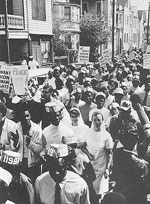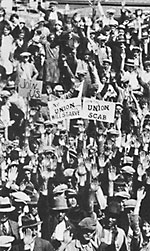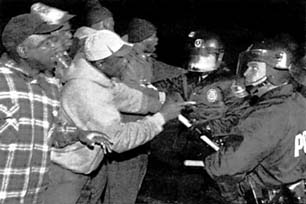
Charleston
hospital workers waged long and bitter struggle for recognition of their
union in 1968-69.

Gastonia
1929: left-led black and white textile workers in labor revolt faced vigilantes,
National Guard, legal frame-up.
June 2001
Key Battle for Labor Rights and Black Freedom

Charleston longshoremen
defend themselves against attack
by union-busting cop
army, 20 January 2000. (Photo: Mic Smith)
Only Hard Class Struggle Can Defeat the Racist Union-Busters
The fight to defend the Charleston Five – black longshoremen in South Carolina threatened with years in prison for defending their union – is a key battle linking labor struggle with the cause of black freedom. Like the reign of racist police terror in Cincinnati and the fight to free death row journalist Mumia Abu-Jamal, it focuses a searchlight on harsh realities in America, where capital’s exploitation of labor rests on a bedrock of racist oppression.
International Longshoremen’s Association Local 1422 members Jason Edgerton, Elijah Ford Jr., Kenneth Jefferson, Ricky Simmons and Peter Washington Jr. are to be tried on federal charges of “felonious riot.” They are targets of a racist anti-union assault aimed at the heart of labor, as the bosses seek to break a key outpost of unionism in the South: Charleston, the East Coast’s second largest port. The struggle began when the Nordana shipping line ended a 23-year agreement with the ILA and contracted the scab WSI stevedore firm. When WSI began working the Nordana Skodberg, the scab operation was met on 20 January 2000 by picketers from the overwhelmingly black Local 1422 as well as the mainly white clerks’ and checkers’ Local 1771.
The response was a full-scale police riot by 600 riot-clad cops from a range of state and local agencies, together with prison guards, who used tear gas, rubber bullets, concussion grenades, as well as armored cars, helicopters, sniper details, police boats and attack dogs reminiscent of those unleashed against civil rights marchers in the ’60s. In a blatant provocation, a cop lunged out of formation to club Local 1422 president Ken Riley as he tried to calm the situation. Seeking to defend themselves, longshore workers were savagely beaten to the ground. The union later discovered that local jails had been cleared in anticipation of mass arrests.
With the union hall surrounded by cops armed to the teeth, nine unionists were charged with civil trespass. Yet state business leaders howled for heavy penalties against “agitators.” The head of the Chamber of Commerce ranted that South Carolina could “not afford to let the union bosses take over and dictate.” The labor-hating Post and Courier intoned, “Labor violence on Charleston’s waterfront must not be rewarded.” Vowing “jail, jail and more jail” for the black unionists, Republican attorney general Charles Condon – a Bush advisor who later hailed the appointment of Confederate apologist John Ashcroft as attorney general – filed federal charges.
When a judge dismissed these, Condon convened a grand jury to hit the Charleston Five with felony charges carrying up to five years in prison. In a mockery of the capitalist “justice” system’s supposed principle of “innocent until proven guilty,” the Five are subjected to a 7 p.m. to 7 a.m. curfew and forbidden to leave the state. The entire workers movement must mobilize its power demanding Drop all charges now – Hands off the Charleston Five!
Rip Up the Flag of Slavery and Slave Labor “Right to Work” Laws!
Three days before the police riot of 20 January 2000, ILA Local 1422 participated in a march of tens of thousands in Columbia, the state capital, demanding that the Confederate flag be taken down from above the statehouse. The brutal attack in Charleston was in good part a “payback” from the racist state government. Yet the protest against the hated flag of slavery and KKK terror was exploited as a vehicle by the capitalist politicians of the Democratic Party – the same party of racism and exploitation that put the flag there in 1962 as a threatening show of hatred of the civil rights movement against Jim Crow segregation. In response to the protests, a “compromise solution” backed by Governor James Hodges and Charleston mayor Joseph Riley, Democrats elected with union backing, moved the racist banner from the top to the front of the building.
South Carolina labor does the legwork for the Democrats, and in return gets kicked in the teeth. After the longshoremen helped elect Hodges governor, he nominated Local 1422 president Ken Riley to the Port Authority, that is, to serve as a “labor statesman” helping the bosses administer port workers’ exploitation. The maritime companies said no way – and the nomination was promptly withdrawn. The longshoremen, together with a range of “progressive” groups, responded by picketing the state Democratic Party in Columbia. Yet in Charleston, the Local 1422 union hall doubles as Democratic headquarters! Now the Republicans seek to ram through a bill, known as the “Riley Act,” banning “card-carrying” unionists from serving on state boards so that, in the words of lieutenant governor Harvey Peeler, “the right-to-work foundation of our pro-business climate is never again compromised by union politics.”
Today, the two Carolinas boast the lowest rate of unionization in the entire United States: just above 4 percent. South Carolina is one of two states that do not comply with the federal minimum wage law. Low-wage, non-union labor has been the attraction for “run-away shops” including from France (Michelin tires) and Germany (BMW and others). Seeing themselves as born-again plantation overseers, the capitalist authorities have a special hatred for black longshore unionists who are a nucleus of labor organization in this state, where attempts to drive workers into virtual slave-labor conditions are cynically called “right-to-work” laws.
Reformists respond with appeals for “pro-labor” legislation. Yet so long as the workers movement is chained to the mechanisms of class collaboration and the capitalist state, the bosses will be the winners; so long as labor buys the union bureaucrats’ snake oil prescription of pressuring the bosses’ government, failure will be the result. “Right-to-work” laws will not be eliminated by lobbying the Democrats, but only through hard class struggle. To defeat the exploiters, to win black freedom and the emancipation of all the oppressed, the fight must be for a workers government.
For a Class-Struggle Fight to Organize the South!
Under pressure from solidarity action by workers in Europe outraged
by the attack on the Charleston dockers, Nordana eventually signed a new
agreement with the union. Despite this, the WSI stevedore firm has continued
to pursue a $1.5 million civil suit against the ILA locals, their leaders
and 27 individual members. The bosses view the case as central to their
plans to break union power coastwise. Already, half of New Orleans longshore
operations are reportedly non-union, while in Houston the figure is 80
percent. The response must be an all-out mobilization of labor/black power,
bringing in the unorganized and broad layers of the poor and oppressed,
and pointing the way towards a class-struggle fight to unionize the South.
This poses point-blank the urgent need for a new, class-struggle leadership
of labor and all the oppressed.
The old-line ILA tops under John Bowers have been openly hostile to the Charleston Five defense, not only because Local 1422 leaders are part of a reformist “opposition” grouping in the union, but because the Charleston case rocks the boat of the ILA tops’ cozy relation with the bosses. These are the “labor leaders” who let the Domino Sugar strike twist in the wind for 20 months until it went down in bitter defeat. Today they smile benevolently on ILA Local 1964’s sweetheart deals with New York greengrocer stores aimed at spiking a UNITE Local 169 unionization campaign among horribly exploited immigrant workers.
Yet these sell-out artists are part of the AFL-CIO leadership under the liberal John Sweeney. Like his predecessors, Sweeney pours millions of dues dollars into campaigns for the bosses’ Democratic Party. Eight years of the Democrats in the White House meant Wall Street gorging itself on a speculators’ boom as millions of black mothers and kids were thrown into slave-labor “workfare.” The “Effective Death Penalty Act” accelerated legal lynching while U.S. imperialism waged war on working people around the world. But today, as the Republican Bush administration revs up vicious attacks on labor and blacks, the labor bureaucracy will be working overtime to keep all protest subordinated to the Democrats, especially through the agency of black front men for this racist party like Jesse Jackson and the Rev. Al Sharpton.
It has been widely remarked that the attack on Charleston longshoremen “brings home” the class war against dockers that the bosses have waged from Liverpool, England to Santos, Brazil. The international nature of capitalism – and of its grave-digger, the working class – is the basis of the shipping and longshore industries. But under the watchword of “anti-globalization,” labor bigwigs have pushed the poison of protectionism, pitting U.S. workers against their brothers and sisters overseas. Yet those who took action against the scab Nordana shipping operation were not the American labor bureaucrats – the ILA tops kept longshoremen working the Skodsberg in several ports. Instead, Spanish dockers in Barcelona and Valencia “hot-cargoed” the Skodberg in solidarity with Charleston unionists. Only international workers solidarity – based on a program of class struggle – can defeat the bosses’ game of divide and conquer.
Today efforts are underway to spark labor actions in various countries on the first day of the Charleston Five trial, and for West Coast ILWU longshoremen to shut ports on that day and call on the ILA to join such an action. The potential for mobilizing the power of labor in the fight against racist repression was indicated when the ILWU shut all West Coast ports for a ten-hour shift in April 1999 to demand freedom for Mumia Abu-Jamal, the radical black journalist on Pennsylvania’s death row. This first step must be deepened and extended; work stoppages and strikes for Mumia’s freedom – in which Pennsylvania ILAers should play a key role – are crucial, and in fighting a crucial battle for black freedom would strengthen all of labor.
In the face of the persecution of the Charleston Five and the escalating attack on union rights, what’s called for is a solid longshore strike against this racist anti-labor attack. Shut down all three coasts. Stop the bosses cold before they do what they did in Liverpool! Hard-hitting strike action could go a long way towards forging class-struggle unity between West and East Coast longshoremen and show the way for a massive unionization drive. Yet these urgently needed steps require a head-on struggle against the pro-capitalist labor bureaucracy which chains the working class to the racist exploiters and their hired politicians.
The need to oust the labor bureaucracy and forge a class-struggle, revolutionary leadership is posed in the clearest terms by the urgent task of organizing the unorganized and unionizing the South. This will not be won by half-measures, and reliance on the Democrats would mean death to such a struggle. A real, massive unionization drive would come straight up against the guard dogs of capitalist property and privilege, from the cops to their cohorts in white sheets. It would pose an all-out fight to root out racist oppression. That is why the “business unionists” leading the American labor movement have let the South remain an open-shop hell, allowing the bosses to get away with murder in every sense of the word and – as in the case of the ILA – maintaining separate black and white locals in some areas.
Labor Must Champion the Fight for Black Freedom
Charleston vividly shows the intimate connection between the fight for black liberation and the working-class struggle against the capitalist owners who rule this country. Underlining the need for the entire working class to fight for black freedom, Karl Marx wrote of chattel slavery in America that “Labor cannot emancipate itself in the white skin where in the black it is branded” (Capital). Like every ruling class in history, the Southern slave owners were unmoved by “moral suasion”: slavery was abolished only through the “second American revolution,” the Civil War, whose first shots were fired at Fort Sumter in Charleston harbor. Armed and enrolled in the Union army, former slaves played a key role in turning the tide to defeat the Confederacy:
“In Charleston, proud Charleston, where the slaveholders had begun their war...the famous Fifty-Fourth, the Negro regiment from Massachusetts, marched past the stately mansions singing John Brown’s Body, while in their wake came thousands of Negroes, terrible in their joy and strength at being free. They surged into the mansions and slave pens shouting ‘Liberty!’ They burned the auction blocks, destroyed whips and branding irons, wrecked the stocks which had held them, shattered the many specialized tools of torture with which they had been cut, maimed, twisted, and flogged for more than two hundred and fifty years.”After the war, South Carolina was home to a Radical Reconstruction government known as the “Black Parliament,” and in 1867 Charleston dockers founded the Longshoremen’s Protective Union Association, the first union of black workers. Yet the promise of Reconstruction was sold down the river by the Northern capitalists with their infamous Compromise of 1877 with the Southern Democratic heirs to the slavocracy after the stalemate of the 1876 presidential election (see “1876,” The Internationalist No. 9, January-February 2001). Waving the Confederate rag of the slaveholders’ rebellion, Ku Klux Klan night-riders were called out to terrorize and disenfranchise the former slaves and their descendants – and to keep the deep South “free” of unions.
–Boyer and Morais, Labor’s Untold Story (1955)
Labor cannot unionize the South unless it sets its sights on rooting out the bloody legacy of the Confederacy, and that is a revolutionary struggle in the most literal sense. At the same time the need for workers internationalism is highlighted by the growing presence of immigrant workers, many of them “undocumented,” in Southern industries and businesses. The Kluxers’ brand of nativist fascism has always fed off “America-firstism” and xenophobia; the same lynch-rope terrorists who target black people and unionists go after immigrant workers with a vengeance. Labor must fight for full citizenship rights for all immigrants, who from one coast to the other have played a dynamic role in recent union drives among the most exploited sections of the U.S. proletariat, many of them women workers.
What all these tasks demand is to break from the Democrats and wage a class struggle against all capitalist parties (including Nader’s red-white-and-blue Greens), forging a revolutionary workers party that fights for black liberation through socialist revolution. Against those who preached the pipe dream of overcoming slavery through conciliation with the master class, the great Frederick Douglass insisted: “Without struggle there is no progress.” Today the road to freedom for capitalism’s wage slaves in racist America is that of intransigent revolutionary struggle, together with workers the world over, to take society’s wealth and resources out of the hands of the exploiting few and put them in the service of the working people. This fight for workers revolution is the cause and purpose of the Internationalist Group, section of the League for the Fourth International. n
To contact the League for the Fourth International or its sections, send an e-mail to: internationalistgroup@msn.com